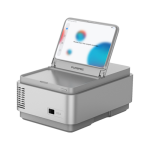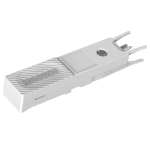Biofunctionalized dissolvable hydrogel microbeads enable efficient characterization of native protein complexes
The characterization of protein complex is vital for unraveling biological mechanisms in various life processes. Despite advancements in biophysical tools, the capture of non-covalent complexes and deciphering of their biochemical composition continue to present challenges for low-input samples. Here we introduce SNAP-MS, a Stationary-phase-dissolvable Native Affinity Purification and Mass Spectrometric characterization strategy. It allows for highly efficient purification and characterization from inputs at the pico-mole level. SNAP-MS replaces traditional elution with matrix dissolving during the recovery of captured targets, enabling the use of high-affinity bait-target pairs and eliminates interstitial voids. The purified intact protein complexes are compatible with native MS, which provides structural information including stoichiometry, topology, and distribution of proteoforms, size variants and interaction states. An algorithm utilizes the bait as a charge remover and mass corrector significantly enhances the accuracy of analyzing heterogeneously glycosylated complexes. With a sample-to-data time as brief as 2 hours, SNAP-MS demonstrates considerable versatility in characterizing native complexes from biological samples, including blood samples.
In conclusion, the SNAP-MS workflow significantly enhances the efficiency of purifying protein complexes from biological samples through its bead-dissolving scheme and improves the feasibility and accuracy of structural characterization of the target proteins using native MS and the associated top-down analysis. SNAP beads are compatible with a diverse range of baits, which facilitate high-affinity purification of not only overexpressed proteins from cell lysates but also natural protein complexes from blood samples. Native MS provides multi-level structural information on the purified proteins, including sequence, PTMs, oligomerization, binding, and complex topology. It can also screen for optimal expression and preparation conditions for further structural characterization using conventional tools such as cryo-EM. Bait-release from the bait-target complexes in the workflow enables interpretation of spectra of highly heterogeneous protein systems acquired a wide range of commercial mass spectrometers. This facilitates accurate higher-order structure characterization of heterogeneously glycosylated protein systems. SNAP-MS demonstrates the potential to liberate structural characterization from reliance on in vitro reconstituted protein complexes, and to serve as a general strategy for characterizing natural protein complexes in studies employing biological samples.
Nature Communications, (2024) 15: 8633 (IF: 14.7),



